An Incredibly Big Bison Grazing in the Field
Bison, also known as buffalo or wisent, is a genus of two ox-like grazing animals in the family Bovidae. The American bison, also known as the buffalo or plains buffalo, is a North American species, while the European bison, also known as the wisent, is a European species. Both animals have seen their populations greatly depleted by hunting, and now live in restricted protected areas that are just a portion of their former ranges.
In some aspects, the American bison differs from domestic cattle or oxen. It's bigger, with a long, heavy head that's held low and can't be lifted to shoulder height. Bison also have a prominent hump at the shoulders, heavy forequarters, and 14 ribs rather than the 13 seen in cattle. The dark brown shaggy hair is thick and shaggy. It normally develops a beard on the chin and grows particularly long on the head, collar, and shoulders. A white bison is born on rare occasions; these uncommon species were particularly revered — even worshipped — by American Indians.
Bison horns are narrow and upcurved in both sexes, with the cow's being bigger.
Bison are strong, big animals. At the shoulder, a mature bull stands about 2 metres (6.5 feet) tall and weights more than 900 kilograms (1,980 pounds). The female is approximately 1.5 meters (5 feet) tall and weights approximately 320 kilograms (700 pounds).
Bison live in small groups called bands, with one or two females and multiple generations of offspring as the basic unit. Adult males either hang out on the edges of the band or form their own small groups. The coexistence of dozens or even hundreds of individual bison bands will result in large temporary bison herds. Bulls compete in head-butting competitions to establish their social supremacy during the breeding season, which runs from July to August. After a nine-month gestation period, the cow normally gives birth to a single calf in May. The band as a whole is dedicated to ensuring the safety of the children.
Bison like herbs and vegetables, but can feed on twigs and leaves as well. Bison herds make brief seasonal migrations, traveling a few hundred miles south in the winter and only returning north as the weather warms up again. Their preferred gait is a plodding walk, but they can also trot, canter stiffly or sprint in a rolling motion. Despite their size, they are agile and fast, achieving speeds of 65 kilometers per hour (40 miles per hour). Bison are erratic beings. They can be approached closely without alarming them at times, but they will stampede at the slightest disturbance at other times.
An analysis of mitochondrial DNA from a 120,000-year-old fossil long-horned bison (B. latifons) from Colorado and a 130,000-year-old fossil of what was most likely a steppe bison (Bison cf. priscus) from the Yukon suggested that the first bison in North America migrated from Asia over the Bering Land Bridge between 95,000 and 135,000 years ago before spreading rapidly throughout the continent. The plains bison (B. bison bison) and the wood bison (B. bison athabascae) are two subspecies of American bison, according to some authorities, but the distinctions are slight.
Plains bison once roamed most of the United States east of the Rocky Mountains, as well as Canada's Great Plains regions. The wood bison, who lived in northern Canada and Alaska, were much outnumbered. When Europeans arrived, an estimated 50 million plains bison roamed North America, making it the largest gathering of large animals known to recorded history. The bison supplied the Plains Indians with meat for food, hides and fur for clothes and shelter, and sinew and horn for weapons, despite the fact that their hunting efforts had no effect on the bison population.
Bison were killed in ever-increasing numbers as white civilization spread westward in the 18th and 19th centuries: they were hunted for subsistence, commercial selling of their meat and skins, or purely for recreation. Bison had been wiped out east of the Mississippi River by the early nineteenth century. In the 1860s, railroads were built through the Great Plains, decimating the large herds that grazed on the vast grasslands there. In 1867–68, one hunter, William F. Cody, killed 4,280 buffalos while selling beef to railroad building crews.
The killing of bison by white men had a deliberate political goal: to strip Indians of their means of livelihood, making it possible to push them into reservations or into settled agricultural pursuits. The whites' unrelenting slaughter of the bison herds was a major source of animosity between the Indians and the whites. By 1870, the Great Plains bison population had been split into two sections, one north of the Union Pacific railway line and the other south of it. By 1875, the southern herd had been entirely wiped out, while the northern herd had been completely depleted by 1885. In 1889, North America's bison population had shrunk to less than 1,000.
As the bison neared extinction around 1900, cattlemen and conservationists on both sides of the frontier banded together to see that the remaining species were protected in government parks, zoos, and ranches. Currently, commercial herds number up to 400,000 people. In the United States and Canada, more than 20,000 plains bison are protected in preserves, and more than 10,000 wood bison remain on preserves in Canada.
While conservationists are worried about preserving genetic diversity within protected bison herds, this number is adequate to ensure the species' survival.
In Canada, the wood bison subspecies is considered endangered.
-
 0:15
0:15
chindergeelfiomag
5 years agoBig Elder Deer Eating Fresh Grass In Field
44 -
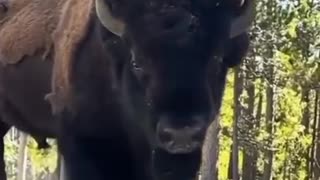 0:15
0:15
Welcome to the Jungle
7 months agoBiggest Bison 🦬 in the world 😱😱
99 -
 0:13
0:13
SEE NATURE
1 year agoBison Grazing
4 -
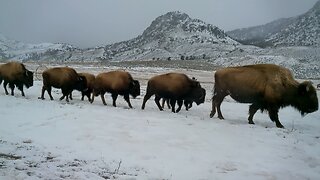 4:55
4:55
JFConservation
1 year agoTHE UNSUSTAINABILITY OF THE CURRENT WILD BISON MANAGEMENT PROGRAM IN YELLOWSTONE!
45 -
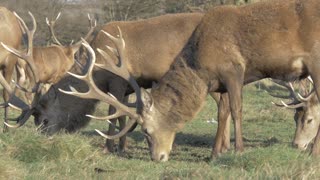 0:14
0:14
chindergeelfiomag
5 years agoGreat Elder Deers Eating Grass In Field
36 -
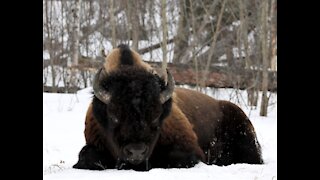 1:17
1:17
Nellie1221
3 years agoWoodland Bison winter fedding
231 -
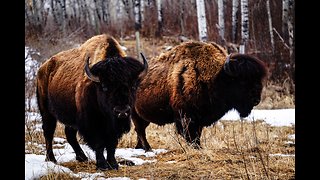 0:24
0:24
Ariann
5 years agoBison Running
133 -
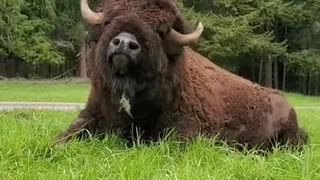 0:25
0:25
Welcome to the Jungle
7 months agoBison Bull
64 -
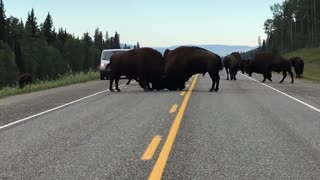 0:12
0:12
Alwaysbella
6 years ago $55.09 earnedAmazing Close Footage Of A Buffalo Fight In The Middle Of A Highway
4.82K -
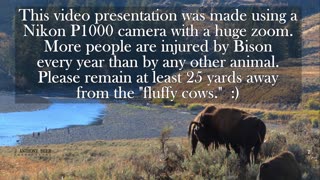 4:19
4:19
AtHomeSanitySavers
8 months agoThe American Bison - Yellowstone National Park (2023)
1